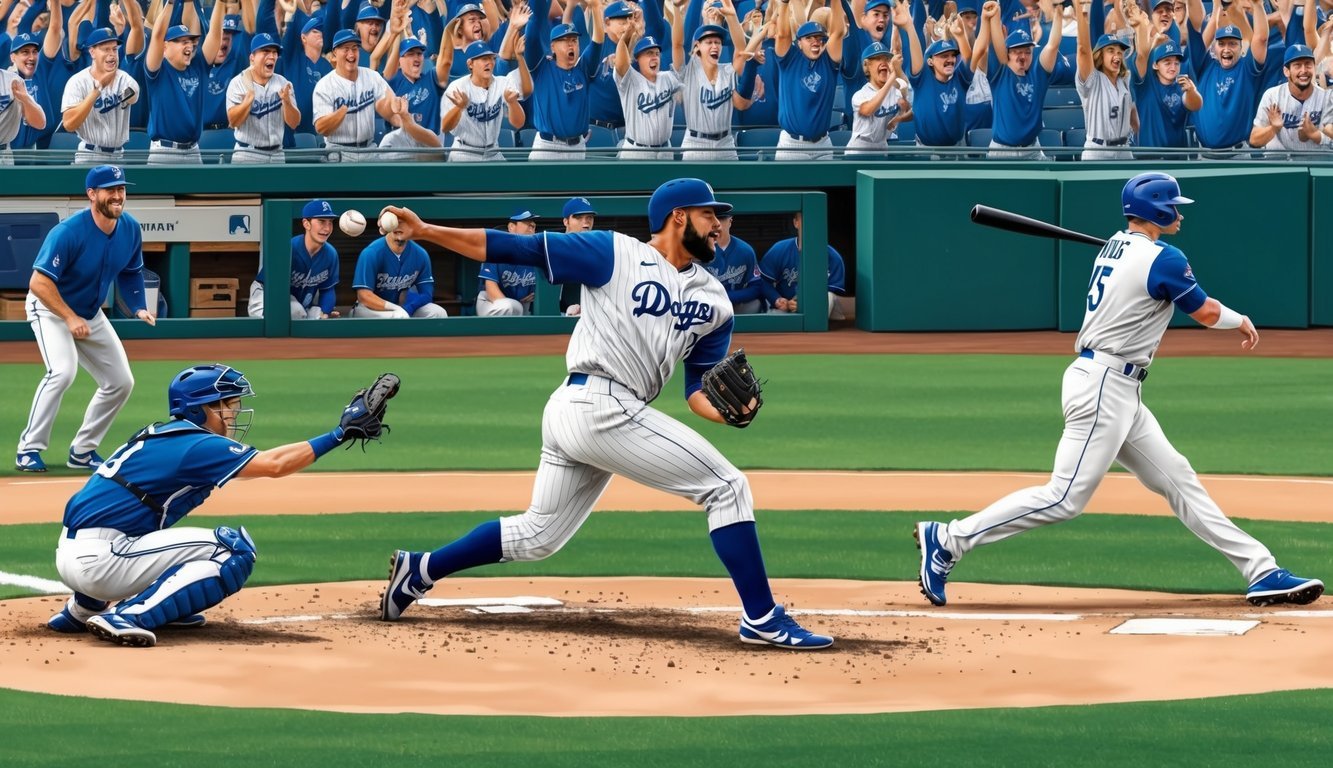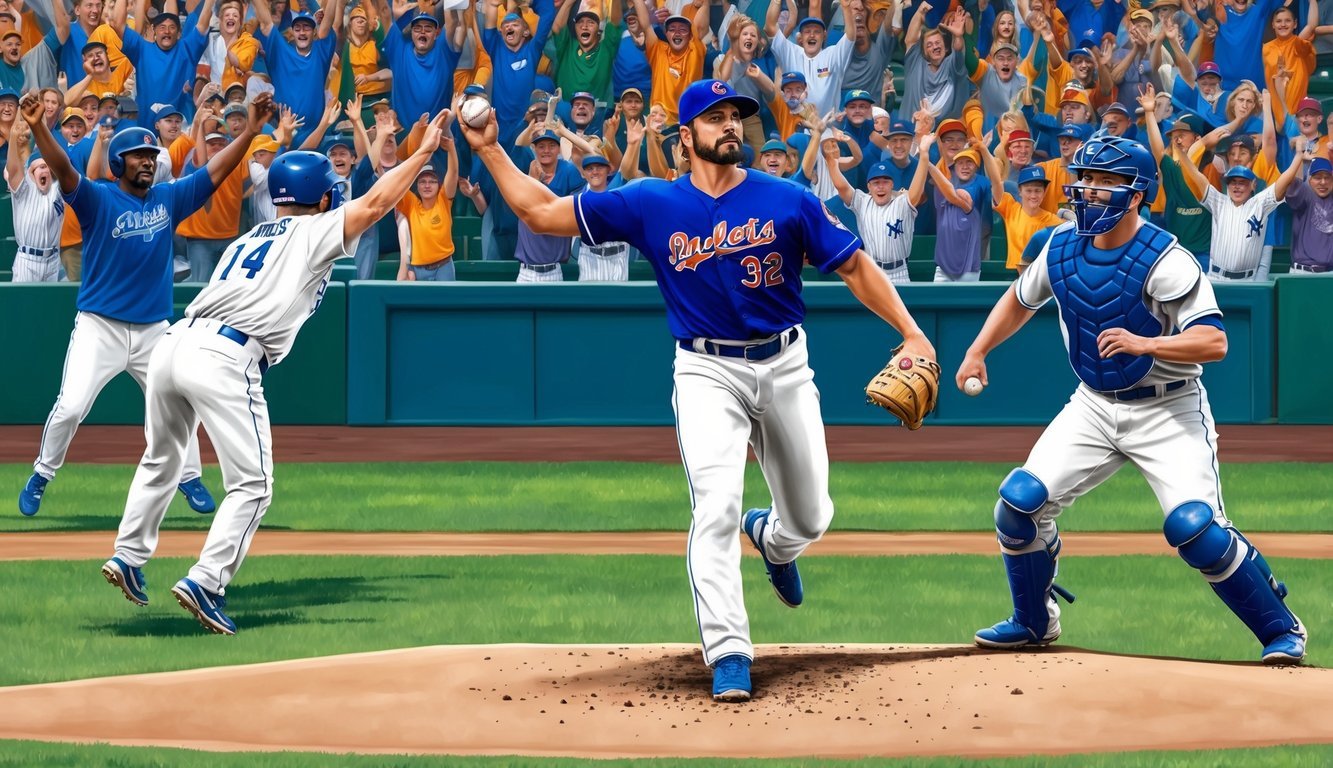Baseball fans dream of witnessing history unfold on the diamond.
One of the rarest and most exciting feats in the sport is the no-hitter. A pitcher, or group of pitchers, completes a game without allowing the opposing team to record a single hit. This extraordinary achievement requires skill, focus, and often a bit of luck.
No-hitters have captivated audiences since the early days of Major League Baseball.
While batters can still reach base through walks, errors, or hit-by-pitches, they remain unable to connect bat to ball for a hit. The tension builds with each out, as players and spectators alike wonder if they’re about to witness baseball magic.
Throughout MLB history, legendary pitchers have etched their names in the record books with multiple no-hitters.
From Nolan Ryan’s seven no-hitters to Justin Verlander’s three, these games stand as testaments to pitching dominance.
Even rarer is the perfect game, where no opposing player reaches base at all – the ultimate pitching performance.
The Fundamentals of a No-Hitter
A no-hitter is a rare and exciting achievement in baseball.
It showcases a pitcher’s skill and the team’s defensive prowess, captivating fans and players alike.
Defining a No-Hitter
A no-hitter occurs when a pitcher, or multiple pitchers, complete a full game without allowing the opposing team to record a single hit.
The game must last at least nine innings for it to count as an official no-hit game in the major leagues.
Walks, hit batters, and errors don’t affect a no-hitter.
A batter can reach base through these means, but as long as no hits are recorded, the no-hitter remains intact.
It’s important to note that runs can still be scored during a no-hitter.
For example, a walked batter could steal bases and score on a sacrifice fly.
The Rarity of Achieving a No-Hitter
No-hitters are incredibly rare events in baseball.
On average, only a handful occur each season across the major leagues.
Several factors contribute to their scarcity:
- Pitcher fatigue
- Defensive positioning
- Batter adjustments
- Luck
Even the best pitchers may only throw one or two no-hitters in their entire careers.
Some legendary players never achieve this feat.
The rarity of no-hitters makes them special moments in baseball history.
Fans often save ticket stubs or collect memorabilia from these games as cherished keepsakes.
Historical Significance and Records

No-hitters have captivated baseball fans for generations, representing the pinnacle of pitching excellence.
These rare achievements have left an indelible mark on the sport’s history and record books.
Notable No-Hitters in MLB History
On July 28, 1875, Joe Borden of the Philadelphia White Stockings threw the first recorded no-hitter in Major League Baseball.
This groundbreaking performance set the stage for countless memorable moments to follow.
Johnny Vander Meer’s back-to-back no-hitters in 1938 stand out as a unique feat.
The Cincinnati Reds pitcher accomplished this incredible double on June 11 and 15, a record that remains unmatched to this day.
In 1956, Don Larsen pitched the only perfect game in World Series history.
His flawless performance for the New York Yankees against the Brooklyn Dodgers is etched in baseball lore.
Pitchers with Multiple No-Hitters
Nolan Ryan leads the pack with an astounding seven no-hitters throughout his career.
His first came in 1973, and his last in 1991 at the age of 44, showcasing his remarkable longevity and skill.
Sandy Koufax threw four no-hitters, including a perfect game in 1965.
His dominance on the mound made him one of the most feared pitchers of his era.
Other notable names include Cy Young and Bob Feller, each with three no-hitters to their credit.
In recent years, Justin Verlander has joined this elite group with three no-hitters of his own.
Larry Corcoran holds the distinction of being the first pitcher to throw three no-hitters, accomplishing this feat in the 1880s.
Types of No-Hitters

No-hitters come in different forms, each with its own unique characteristics and level of difficulty.
These variations add excitement and intrigue to the game of baseball.
The Perfect Game Versus the No-Hitter
A perfect game is the rarest and most challenging type of no-hitter.
In a perfect game, the pitcher retires every batter they face.
No opposing player reaches base for any reason.
This means no hits, walks, hit batsmen, or errors.
It’s the ultimate pitching performance.
Perfect games are extremely rare, with only 23 occurring in MLB history.
A regular no-hitter, while still impressive, allows baserunners through walks, errors, or hit batsmen.
The key difference is that no batter records a hit.
Combined No-Hitters
Combined no-hitters involve multiple pitchers working together to achieve the feat.
This type of no-hitter has become more common in recent years.
Managers often use this strategy to protect pitchers’ arms or respond to injuries during the game.
It can be a team effort, with each pitcher contributing valuable innings.
Combined no-hitters still count officially, though some purists argue they’re less impressive than those thrown by a single pitcher.
They showcase a team’s pitching depth and collaborative effort.
These performances highlight the importance of bullpen strength in modern baseball.
They also demonstrate how strategies have evolved to prioritize pitcher health and effectiveness.
Pitching Dynamics and Strategy
Throwing a no-hitter requires exceptional skill, strategy, and teamwork.
Pitchers must maintain focus and precision throughout the game, while their teammates provide crucial defensive support.
What It Takes to Throw a No-Hitter
Pitchers aiming for a no-hitter need impeccable control and a diverse arsenal of pitches.
They must mix speeds, locations, and movement to keep batters off-balance.
Mental toughness is crucial, as the pressure builds with each inning.
A strong relationship with the catcher helps in calling the right pitches.
Stamina is essential, as most no-hitters go the full nine innings.
Pitchers often rely on their best offerings but may need to adjust if batters start to figure them out.
Luck plays a role too.
Even great pitches can result in hits, so pitchers need a few breaks to go their way.
How Teams Defend a No-Hitter
Defensive players become hyper-aware as a no-hitter progresses.
They position themselves more carefully and take extra risks to preserve the feat.
Infielders might play deeper to cover more ground.
Outfielders often shade towards the lines to prevent extra-base hits.
Catchers work hard to block pitches in the dirt and prevent passed balls.
Managers may substitute defensive specialists late in the game.
The whole team avoids mentioning the no-hitter to the pitcher, following baseball’s superstitious traditions.
As the tension builds in the stadium, teammates focus on their positions, ensuring that every play counts as they strive to maintain the pitcher’s momentum.
In the dugout, the coaches strategize about the appropriate moments to utilize their players, including the designated hitter role in baseball, to maximize their chances of securing a win.
With every pitch, the atmosphere thickens, as fans hold their breath, aware of the history that could unfold before them.
Communication becomes key.
Fielders coordinate to cover potential bunts or stolen base attempts.
Every play is crucial, as a single error could ruin the no-hitter even if no hits are allowed.
No-Hitters Across Different Scenarios

No-hitters can occur in various contexts, each with its own unique significance.
These rare achievements captivate fans and players alike, whether in high-stakes postseason games or under unusual circumstances.
Postseason No-Hitters
Postseason no-hitters are exceptionally rare gems in baseball history.
Only three pitchers have achieved this feat in MLB playoffs.
Don Larsen’s perfect game in the 1956 World Series stands out as the pinnacle of postseason pitching performances.
Roy Halladay joined this elite club in 2010, throwing a no-hitter for the Philadelphia Phillies in the National League Division Series.
The most recent addition came in 2022 when the Houston Astros combined to no-hit the Phillies in the World Series.
These accomplishments carry extra weight due to the pressure and quality of opposition in playoff games.
Extraordinary Circumstances
No-hitters can happen under unique conditions, adding to their mystique.
Extra-inning no-hitters are particularly impressive, as pitchers must maintain their focus for longer than usual.
Fred Toney and Hippo Vaughn made history in 1917 with a double no-hitter through nine innings.
Toney completed his no-hitter in the 10th, while Vaughn lost his in the same frame.
Weather can play a role too.
Jim Maloney pitched a 10-inning no-hitter in 1965 after a rain delay.
Some no-hitters have been shortened by rain, like Andy Hawkins’ 8-inning no-hitter in 1990, though it wasn’t officially recognized due to MLB rules.
